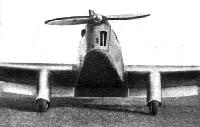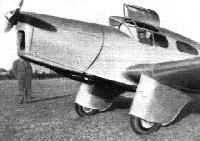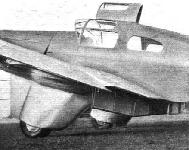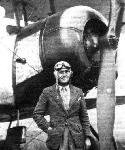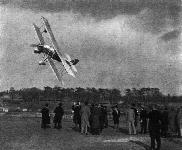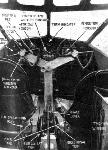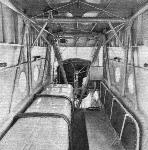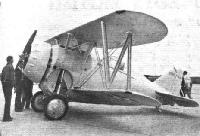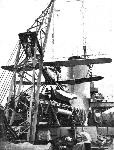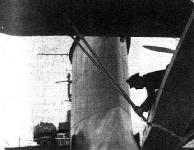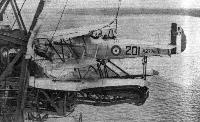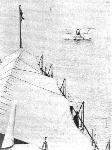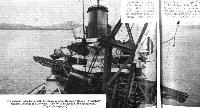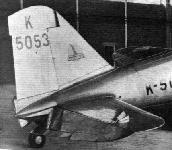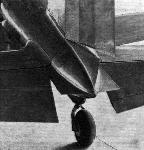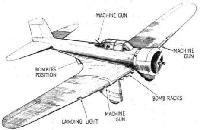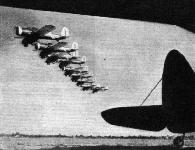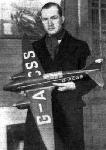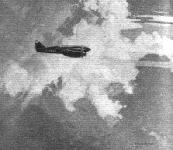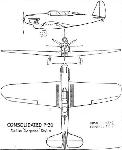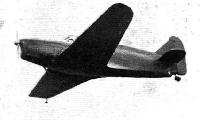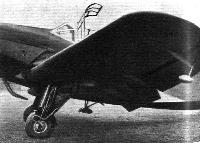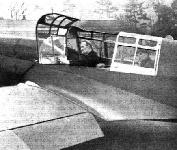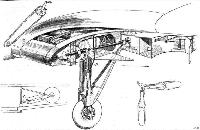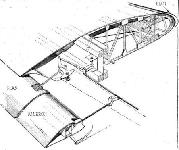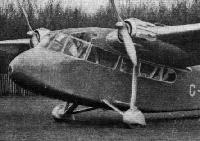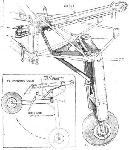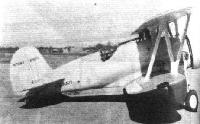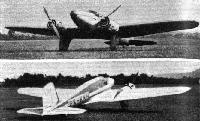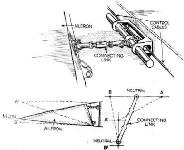Фотографии
-
A bomber-fighter - the Curtiss BF2C-1 single-seater with 700 h.p. "Cyclone" engine. Note the sliding cockpit cover and retractile undercarriage.
Самолёты на фотографии: Curtiss F11C-3 / Hawk III / BF2C-1 / Model 68 - США - 1933
-
Регистрационный номер: I-MAGO STILL FASTER. A development of the S.73, illustrated in Flight of December 20 last year, this new Savoia-Marchetti S.79, with retractile undercarriage, is reputed to cruise at 217 m.p.h. at 13,000 ft. The engines are Piaggio "Stella IX R.C." of 610 h.p. and the normal load is 6,614 lb. Three S.73S, it will be remembered, have been delivered to S.A.B.E.N.A.
Самолёты на фотографии: Savoia-Marchetti / SIAI SM.79 Sparviero - Италия - 1934
-
Регистрационный номер: G-ADBF Самолёты на фотографии: Miles Falcon M.3 / Hawcon M.6 - Великобритания - 1934
-
A view which gives a good idea of the area of the flaps
Самолёты на фотографии: Miles Falcon M.3 / Hawcon M.6 - Великобритания - 1934
-
The clean undercarriage and the new windscreen
Самолёты на фотографии: Miles Falcon M.3 / Hawcon M.6 - Великобритания - 1934
-
The flaps seen from behind
Самолёты на фотографии: Miles Falcon M.3 / Hawcon M.6 - Великобритания - 1934
-
VETERANS BOTH! Mr. C. L. Pashley and one of the Southern Aero Club's lately discarded 504 Ks. Many pilots must regret the passing of the "blip" switch and the "fine adjustment."
Самолёты на фотографии: Avro Avro 504 - Великобритания - 1913
-
NEW ZEALAND'S CHOICE. Sir James Parr, High Commissioner for New Zealand, last week attended Brooklands for a demonstration of one of the twelve "Vildebeests" which have been ordered for coast defence work. Mr. J. Summers, Vickers' chief test pilot, treated Sir James and a large party of visitors to a brilliant display of flying.
Самолёты на фотографии: Vickers Vildebeest / Type 132 - Великобритания - 1928
-
Регистрационный номер: G-ACYF [2] Giffard Bay, on the beach at St. Helier, with three of the service "Dragons" in the background. This picture was taken immediately after landing and before the inevitably large crowd collected.
Самолёты на фотографии: De Havilland Dragon Rapide / Dominie / D.H.89 - Великобритания - 1934De Havilland Express Air Liner / D.H.86 - Великобритания - 1934
-
Регистрационный номер: VH-UVS TO AID EMPIRE DEVELOPMENT. The first D.H. "Dragon Rapide" to bear Australian registration letters, the machine illustrated will be used to inspect arrangements for the supply of Shell products in Australia and to collect data applying to their use.
Самолёты на фотографии: De Havilland Dragon Rapide / Dominie / D.H.89 - Великобритания - 1934
-
Регистрационный номер: VH-UUA, G-ACWE, HX789, VT-AKM A MAJESTIC CLOUDSCAPE. Taken by a Flight photographer among snow-clouds near Hatfield last week, this impressive picture shows the sixth and last D.H.86 of the fleet ordered by Qantas Empire Airways for the Singapore-Brisbane section of the Empire route.
Самолёты на фотографии: De Havilland Express Air Liner / D.H.86 - Великобритания - 1934
-
Регистрационный номер: G-ACYF [2] The controls and special instruments of Giffard Bay. Later machines for Jersey Airways will be fitted with swing-over controls.
Самолёты на фотографии: De Havilland Express Air Liner / D.H.86 - Великобритания - 1934
-
STEEL AND STONE: A fine pictorial impression from New York's East River airport. The nose of the Bellanca seaplane silhouetted against Manhattan's skyscrapers is photographically effective, but a trifle disconcerting, perhaps, to the eye of the all-weather pilot!
Самолёты на фотографии: Bellanca Model P Airbus / 66 Aircruiser - США - 1930
-
Stressed - skin monocoques have not put the fabric-covered welded structure entirely "out of business." Note, in this view of the Bellanca's cabin, the long-range tank strapped to the floor.
(BottomСамолёты на фотографии: Bellanca 77 Bomber - США - 1934
-
Bombs are carried partially buried in the lower wing "stubs" and in the fuselage. The great depth of the fuselage and the disposition of the guns are noteworthy.
Самолёты на фотографии: Bellanca 77 Bomber - США - 1934
-
Strange to British eyes, this Grumman have very high performance. The single-seater has a 700 h.p., two-row "Whirlwind." Note how the undercarriage retracts into the fuselage.
Самолёты на фотографии: Grumman F2F - США - 1933
-
Регистрационный номер: CF-AVD The first D.H. "Dragon" seaplane in Canada.
Самолёты на фотографии: De Havilland Dragon / D.H.84 - Великобритания - 1932
-
First of the standard British gears to retract laterally, that of the British Klemm "Eagle" (illustrated in detail on the left) embodies the neat locking device shown in the small sketch on the right.
Самолёты на фотографии: British Klemm BK-1 Eagle - Великобритания - 1934
-
NEW ZEALAND'S ROYAL VISITOR: The Duke of Gloucester, when he was in New Zealand, made a long flight over some of the famous valleys and lakes in South Island. He is seen here about to embark in the New Zealand Air Force "Puss Moth," which was piloted by Flt. Lt. M. Buckley, at Invercargill Aerodrome.
Самолёты на фотографии: De Havilland Puss Moth / D.H.80 - Великобритания - 1929
-
The catapult retracted and the aircraft being lowered on to it by the crane.
Самолёты на фотографии: Hawker Osprey - Великобритания - 1930
-
The rigger removing jury struts before a flight
Самолёты на фотографии: Hawker Osprey - Великобритания - 1930
-
Регистрационный номер: K2775 [3] Ready to take off : The "Osprey" at the rear stops of the catapult with engine running and pilot and observer bracing themselves in the cockpits.
Самолёты на фотографии: Hawker Osprey - Великобритания - 1930
-
Самолёты на фотографии: Hawker Osprey - Великобритания - 1930
-
AFTER THE FLIGHT: The "Osprey" is taxying back to be hoisted on board.
Самолёты на фотографии: Hawker Osprey - Великобритания - 1930
-
Регистрационный номер: K2775 [3] The catapult extended in both directions, and the Hawker "Osprey" ("Kestrel" engine), heading into the wind. The Forth Bridge is in the background.
Самолёты на фотографии: Hawker Osprey - Великобритания - 1930
-
Регистрационный номер: K2775 [3] Up She comes: The observer has attached the lifting tackle and the crane is raising the aircraft out of the water.
Самолёты на фотографии: Hawker Osprey - Великобритания - 1930
-
Самолёты на фотографии: Northrop Gamma / A-13 / A-16 - США - 1932
-
Регистрационный номер: K5053 [7] The Northrop being issued to certain attack units of the U.S. Army Air Corps is structurally similar to the bomber version, an example of which was purchased by the British Air Ministry. The Wright Cyclone engine is specified and the maximum speed is about 220 m.p.h.
The addition of the "conservatory" roof above and a bomber's position below somewhat mars the clean lines.Самолёты на фотографии: Northrop Gamma / A-13 / A-16 - США - 1932
-
Регистрационный номер: K5053 [7] The Northrop's flaps. On the left the split trailing-edge flap is shown closed, and the slotted aileron in the "down" position. On the right the flap is open and the aileron "up." Operation is hydraulic.
Самолёты на фотографии: Northrop Gamma / A-13 / A-16 - США - 1932
-
Регистрационный номер: K5053 [7] Protection is afforded to the crew of the Northrop by sliding roof windows, one or more panels being closed or opened at will.
Самолёты на фотографии: Northrop Gamma / A-13 / A-16 - США - 1932
-
Регистрационный номер: K5053 [7] Running-up the engine: The Northrop 2E outside the hangars at Farnborough
Самолёты на фотографии: Northrop Gamma / A-13 / A-16 - США - 1932
-
Регистрационный номер: K5053 [7] The tail unit: Note the trimming "tabs" on the elevators, and the mass balance which disappears into the tailplane.
Самолёты на фотографии: Northrop Gamma / A-13 / A-16 - США - 1932
-
Регистрационный номер: K5053 [7] The upper member of the cruciform stern piece is twisted in order to reduce yawning due to the rotating slipstream.
Самолёты на фотографии: Northrop Gamma / A-13 / A-16 - США - 1932
-
Регистрационный номер: K5053 [7] The bomber's sighting nacelle, shown retracted and lowered. On the right is a front view, showing the window.
Самолёты на фотографии: Northrop Gamma / A-13 / A-16 - США - 1932
-
Structural details of the Northrop 2E. The form which the multiple spars and stringers take is shown on the left, while the general "theme" of the fuselage construction is illustrated on the right.
An example of a multi-spar wing, the American Northrop. Although good structurally, this type makes installation of tanks and bombs difficult.Самолёты на фотографии: Northrop Gamma / A-13 / A-16 - США - 1932
-
The wheels are carried on cantilever forks from the wing spars.
Самолёты на фотографии: Northrop Gamma / A-13 / A-16 - США - 1932
-
This sketch indicates the locations of the bombs and machine guns.
Самолёты на фотографии: Northrop Gamma / A-13 / A-16 - США - 1932
-
The outer wing portions are secured to the centre-section by flanged joints, as shown. On the right are details of the neat steps fitted on the sides of the fuselage; when not in use these steps disappear into the fuselage.
Самолёты на фотографии: Northrop Gamma / A-13 / A-16 - США - 1932
-
"I'LL STRING ALONG WITH YOU." An impression, seen through a hangar door at Miami, of the U.S. Army attack group from Crockett Field, Galvaston, flying Curtiss A.12 monoplanes.
Самолёты на фотографии: Curtiss A-8 / A-12 Shrike - США - 1931
-
Of rather "British" appearance - the Douglas four-seater torpedo-bomber (850 h.p. "Twin Wasp" SR 1830-C).
Самолёты на фотографии: Douglas O-2 / BT - США - 1924
-
Регистрационный номер: CS-AAJ, G-ACSP THE SOUTH ATLANTIC "COMET": Salazar, once Black Magic, the "Comet" which has been bought by the Portugese Government and which is to be flown across the South Atlantic by Bleck and Macedo. Mr. Buckingham, of De Havillands', was flying the machine near Hatfield when a Flight photographer took this picture - the first close-up view of a taken from another aeroplane.
Самолёты на фотографии: De Havilland Comet / D.H.88 - Великобритания - 1934
-
Регистрационный номер: G-ACSS, K5084 THE REPLICA: Mr. C. W. A. Scott with a scale model of the "Comet," presented to him by Flight as a small mark of appreciation of his Melbourne Race success.
Самолёты на фотографии: De Havilland Comet / D.H.88 - Великобритания - 1934
-
ART AND THE AIR: This small reproduction gives some idea of the fine composition and dignity of Norman Wilkinson's painting of the Race-winning "Comet," but it cannot convey the beauty of the colouring. Fine art prints, measuring (without margin) 16 1/2 in. x 20 in., are being offered by the De Havilland Aircraft Co. at ?1 1s.; a few artist's proofs are available at ?3 3s.
Самолёты на фотографии: De Havilland Comet / D.H.88 - Великобритания - 1934
-
On the D.H. "Comet" racing monoplane the wheels retract rearwards into the engine nacelles.
Самолёты на фотографии: De Havilland Comet / D.H.88 - Великобритания - 1934
-
Регистрационный номер: VT-AFM IN INDIA: The Viceroy's Avro 642, Star of India, on the aerodrome at Karachi shortly after its arrival. The Avro Ten, previously used by His Excellency, is now in service with Indian National Airways.
Самолёты на фотографии: Avro Type 642 - Великобритания - 1933
-
An outstanding new monoplane fighter - the Boeing XF7B-1, with 550 h.p. "Wasp."
Самолёты на фотографии: Boeing F7B / P-29 - США - 1934
-
Consolidated P-30 Curtiss "Conqueror" Engine
Самолёты на фотографии: Consolidated P-25 / P-30 / PB-2 - США - 1932
-
The tapered plan form of the wing can be seen in this view of the "Heck" in the air.
Самолёты на фотографии: Parnall Hendy Heck - Великобритания - 1934
-
Самолёты на фотографии: Parnall Hendy Heck - Великобритания - 1934
-
The underside of one wing, showing the flaps in the "down" position, the aileron mass balance, and the recess into which the undercarriage is retracted.
Самолёты на фотографии: Parnall Hendy Heck - Великобритания - 1934
-
The rear half of the left-hand side of the cabin opens as well as the front half. In the rear cockpit is Mr. B. B. Henderson. The flap is shown slightly lowered.
Самолёты на фотографии: Parnall Hendy Heck - Великобритания - 1934
-
The wheels of the Hendy "Heck," when retracted, move upward, rearward and slightly backward.
Самолёты на фотографии: Parnall Hendy Heck - Великобритания - 1934
-
SLOTTED FLAPS: Mr. Henderson achieves a low landing speed on the Hendy "Heck" by means of slotted flaps, the outer portions of which are the ailerons.
Самолёты на фотографии: Parnall Hendy Heck - Великобритания - 1934
-
Hendy "Heck" D.H. Gipsy VI 200 hp. Engine
Самолёты на фотографии: Parnall Hendy Heck - Великобритания - 1934
-
The Fairey III F's (Napier "Lion") of No. 45 (Bomber) Squadron flying over the Pyramids while rehearsing for the Middle East Display.
Самолёты на фотографии: Fairey Fairey IIIF - Великобритания - 1926
-
Регистрационный номер: G-ACUZ This flying picture shows how the Pobjoy "Niagara" engines have been cleanly faired into the wing and indicates the excellent outlook which the new nose design allows the pilot.
Самолёты на фотографии: Short Scion / S.16 - Великобритания - 1933
-
The roomy cabin of the new "Scion"; its proximity to the ground makes entrance and egress very simple for passengers.
Самолёты на фотографии: Short Scion / S.16 - Великобритания - 1933
-
Another British gear which retracts longitudinally is that on the Monospar S.T.11.
Самолёты на фотографии: General Aircraft Monospar ST-4 - ST-12 - Великобритания - 1932
-
Strange to British eyes, this Grumman have very high performance. The two-seater has a 700 h.p. "Cyclone". Note how the undercarriage retracts into the fuselage.
Самолёты на фотографии: Grumman FF / SF / Goblin - США - 1931
-
Регистрационный номер: F-NORD LINES OF FORCE The Latecoere boat, Lieut. Paris, on the step during trials at Biscarosse. The extraordinary wave formation was possibly caused by the Latecoere's previous run along the same line.
Самолёты на фотографии: Latecoere Late 521 / 522 / 523 - Франция - 1935
-
The Boeing XF6B-1, which has a 700 h.p. "Twin Wasp Junior," <...> transferred from the fighter category to the bomber-fighter class.
Самолёты на фотографии: Boeing F6B - США - 1933
-
200 M.P.H.TRAINERS: The widespread adoption of high-speed monoplanes in the U.S.A. has, it would appear, necessitated the provision of special training equipment. Accordingly, the U.S. Army Air Corps has ordered 35 SEV-3XAR monoplanes of the type shown here. Fitted with a 400 h.p. Wright "Whirlwind," the machine has a maximum speed of 200 m.p.h. and the climb to 12,000 ft. occupies ten minutes.
Самолёты на фотографии: Seversky SEV-3 - США - 1933
-
The Airspeed "Retractor" undercarriage folds longitudinally <...> the wheel exposed. This was the first British retractile undercarriage on a production aircraft, and is now fitted to the <...> and "Viceroy." The two drawings show the method of <...> undercarriage.
Самолёты на фотографии: Airspeed Viceroy / AS.8 - Великобритания - 1934
-
Регистрационный номер: PK-KKH The Walraven 2 suggests the "Comet," though actually it was designed earlier.
Самолёты на фотографии: Walraven W-2 - Индонезия - 1935
-
Efficiency is the keynote of the new Bristol design. The low frontal area is indicated.
Самолёты на фотографии: Bristol Bristol 133 - Великобритания - 1934
-
Efficiency is the keynote of the new Bristol design. The picture show the split flaps and retractable undercarriage.
Самолёты на фотографии: Bristol Bristol 133 - Великобритания - 1934
-
Регистрационный номер: C-ADDL [2], L6103 [2] The "Snark," photographed on Marshall's aerodrome at Cambridge.
Самолёты на фотографии: Aero Research Snark - Великобритания - 1934
-
Регистрационный номер: C-ADDL [2], L6103 [2] The cabin top is hinged on radius rods, which lift it as it is moved back; the difficulties of sliding the roof in grooves are thus avoided.
Самолёты на фотографии: Aero Research Snark - Великобритания - 1934
-
These sketches, which are purely diagrammatic, indicate the operation of the De Bruyne system; they should be studied in conjunction with the text.
Самолёты на фотографии: Aero Research Snark - Великобритания - 1934
-
The method of operating the ailerons, shown diagrammatically.
Самолёты на фотографии: Aero Research Snark - Великобритания - 1934
-
A remarkable resemblance is borne by the Curtiss XF13C-1 to certain American "private-owner" types.
Самолёты на фотографии: Curtiss F13C - США - 1934
-
Ultra-modern in appearance, the Northrop XFT-1 is to be still further developed.
Самолёты на фотографии: Northrop XFT - США - 1933
-
The Sikorsky XSS-2 amphibian fighter scout. The engine is the "Wasp" SD-I, of 550 h.p.
Самолёты на фотографии: Sikorsky XSS - США - 1933
-
Consolidated XBY-1 (575 h.p. "Hornet" B-1), is an all-metal adaptation of the commercial "Fleetster."
Самолёты на фотографии: Consolidated XBY - США - 1932
Статьи
- Flight
- Flight Advertisements



